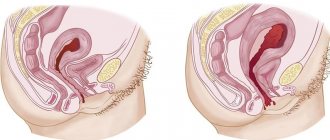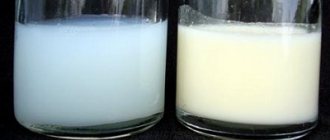26 Feb02118
Translation by Veronika Maslova: A baby who eats too much milk too quickly may be fussy, irritated at the breast and may be thought to have “colic.” Usually such a child gains weight very quickly. Also a typical picture: the baby begins to suck and, after a few seconds or minutes, begins to cough, choke and “fight” with the breast, as there is a strong flow of milk. He can tear himself away from the breast - and you see that mom’s milk is flowing like a fountain. Afterwards, the child sucks on again, but begins to worry again - and the performance is repeated. He may be dissatisfied with the "fountain", but is impatient if the stream flows slowly. This can be a testing time for everyone. In rare cases, a baby may wean itself off the breast altogether, usually around three months of age. What's happening? The baby eats a lot of low-fat foremilk at once. It leaves the stomach quite quickly, and a large portion of milk sugar, lactose, immediately enters the intestines. The enzyme (protein) that helps digest lactose may not be able to handle so much of it at once, and the baby will have symptoms of lactase deficiency - screaming, gas, violent belching, frequent watery green stools.
When does a nursing mother's milk come in?
According to nature’s plan, after birth, a child must gradually adapt to a new life. It is taking into account the needs of the baby that the mother’s body functions, including the appearance of breast milk. Therefore, those mothers who are concerned about how long it takes for milk to arrive after childbirth should pay attention to the following information:
- during the period from the last weeks of pregnancy to the first days after the birth of the baby, colostrum appears;
- in women who give birth for the first time, colostrum is converted into transitional milk on days 3-6, and in women who have already given birth, transitional milk most often appears on days 2-4;
- mature or real milk appears on days 6-10, this figure is the answer to the question on what day milk arrives.
What is the normal milk production rate for a woman by month?
As already mentioned, every woman’s body adapts to the needs of her baby and produces exactly as much milk as the baby needs. At the very beginning of breastfeeding, the baby needs very little - just a few drops of colostrum are enough. Over time and as it grows, the baby needs more and more milk to saturate it.
Periods of adaptation of breast milk production in accordance with the increased needs of the child are called lactation crises. The most effective way to get out of such crises as quickly as possible is to frequently put the baby to the breast, which stimulates an increase in lactation.
The rate of breast milk consumption for a newborn directly depends on his age and body weight. From the second to the tenth day of the baby’s life, it is calculated by multiplying the number of days the baby has lived by ten. As a result of calculations, we obtain the volume of milk for one feeding in milliliters.
Eg:
- day two - 2*10=20 ml (200–240 ml per day);
- day three - 3*10=30 ml (300–360 ml), etc.
To find out how much milk a baby sucks in one feeding, weigh the baby before breastfeeding, and then after, and use simple mathematical calculations to determine the difference. Do this several times during the day, and you will know whether your baby is properly fed.
You can determine that a baby is full by several signs:
- he is calm, content, does not cry, sleeps well;
- he gains weight in accordance with age norms;
- his anthropometric data and development correspond to his age;
- he urinates at least 10 times a day;
- He has stools at least once every 3 days.
The table will help you determine how much breast milk a baby should suck during the first 12 months of his life.
Table: nutritional standards for a child in the first year of life
| Child's age | Amount of milk consumed per feeding, ml | Amount of milk consumed per day |
| 3–4 days | 20–60 | 200–300 ml |
| 1 Week | 50–80 | 400 ml |
| 2 weeks | 60–90 | 20% of the child's weight |
| 1 month | 100–110 | 600 ml |
| 2 months | 120–150 | 800 ml |
| 3 months | 150–180 | 1/6 of the child's weight |
| 4 months | 180–210 | 1/6 of the child's weight |
| 5–6 months | 210–240 | 1/7 of the child’s weight (800–1000 ml) |
| 7–12 months | 210–240 | 1/8–1/9 of the child’s weight |
Do not worry if your milk production is more or less than the norms indicated in the table. Is your baby fed and happy, but do you have any problems with your breasts? Then you can assume that everything is fine with you. Any norms for breastfeeding are approximate values. Each mother-child pair has their own.
If the baby cries, this is not a sign of underfeeding. Due to the immaturity of the digestive system and enzymatic deficiency, he may have intestinal colic and flatulence.
The formation of lactation occurs differently for each woman. The key to successful breastfeeding is the awareness that mother's milk is the most suitable food for the baby, and a strong desire to breastfeed your baby. The technical side when establishing lactation is important, but do not forget that psychological attitude and motivation, physical contact and proper rest are also components of successful breastfeeding throughout the entire period of infancy.
How to speed up the process?
Since the first days after giving birth, the baby needs to be fed something, mothers are worried about a completely adequate question: what to do to make the milk come faster.
In this situation, you need to do the following:
- If the baby shows the slightest signs of anxiety, he needs to be put to the breast, the action can be repeated constantly, at least every 10-15 minutes.
- The child should be given the opportunity to suckle the breast for such a long time until he releases it on his own; it is especially important to perform these actions in the morning. This is the best method that will help solve the question of what to do to make milk flow in nursing mothers, because the female body, receiving signals about the baby’s needs, begins to quickly adapt to them. As for the occurrence of cracks in the nipples during this period, this has nothing to do with the duration of sucking, it directly depends on the incorrect grip: by controlling the baby’s grip, you don’t have to worry about the condition of your breasts.
- Another method that can answer the question of what to do to ensure that breast milk comes in is regular feeding, because if you do not skip the morning feeding of the baby, the time for the appearance of mature milk will significantly accelerate.
- It is worth refusing to use various substitutes in the form of pacifiers, bottles, pacifiers. If the baby is thirsty, then give him your breast for 5-10 minutes, but if he is hungry, then the duration of the breastfeeding process will be increased. In situations where the baby just needs plain water, you can use a pipette, but in no case a pacifier.
- In the case when milk arrives after childbirth in large quantities and the baby simply does not have time to drink it, then you will have to pump it.
What to drink to make your milk flow?
As for drinking, preference is given to warm liquids, a variety of teas, water with lemon and condensed milk.
You should drink more juices, but you should give up coffee, so beloved by many women, as it negatively affects milk production.
In addition, the number of drinks consumed by a woman should include a liter of milk, previously diluted in a liter of tea.
If the amount of milk is small, you need to breastfeed the baby more often and consume the above foods, because this will help increase milk supply, so that both mother and child will be happy.
What should a mother take to stimulate lactation?
Most babies latch on to the breast with frequent attachments and sucking stimulates milk flow. But some babies are too weak or lazy, spitting out the empty breast.
In the second case, special attention should be paid to auxiliary means:
- Lots of warm drinks , mother should drink often.
- Lactation teas (herbal or granules).
- Special preparations for lactation (lactogon, apilak, laktofit).
- Milk formulas for mothers (Bellakt-mama, Mama and I, Mama-bifido, etc.).
In addition to medications, a nursing mother needs to be provided with adequate nutrition and normal sleep.
Traditional recipes for increasing milk supply
If, having figured out what to eat so that milk comes in, the amount of milk still does not increase, then you can use folk recipes. But keep in mind the fact that before using any folk recipe, you need to consult a doctor, because there have been a huge number of cases where, after using alternative medicine methods, women’s milk increased, but it was so bitter that the baby simply refused to drink it.
In this case, the relevant question is what to do so that the milk arrives , but it is not bitter? The answer is quite simple - use nettle infusion.
To make the infusion you need to prepare the following ingredients:
- 40 grams of dried nettle leaves;
- 2 liters of water.
Then, the water must be brought to a boil and poured over the dried leaves. The mixture is left in this form until the water cools completely and filtered. You need to use one large spoon three times a day.
Another remedy that will help increase milk production is a special lactation formula. To prepare it you need to prepare the following ingredients:
- fruits of plants such as dill, oregano, anise, fennel - the quantity of each plant should be the same;
- water.
Next, all the fruits need to be finely chopped; the ideal solution would be to use a coffee grinder.
The product is prepared in the form of tea: one small spoon of the created mixture is poured with boiling water. You need to use the product three times a day.
Painful sensations when milk comes in
Having figured out what to do to make milk flow, you also need to consider the question of how to cope with the painful sensations that young mothers experience when milk comes in. In no case should you endure pain, as this can provoke the development of a number of serious diseases, for example, purulent inflammation, mastitis. To get rid of pain you need to do the following:
- The baby should be fed with both breasts, and the new feeding should begin exactly with the breast on which you finished last time. If you feel like there is less milk in one breast, it most likely means you are feeding less frequently on that breast. In order to remember which breast was the last feeding, it is recommended to pin a pin on that side.
- In order to facilitate the process of milk removal while feeding the baby, the breast must first be warmed; for this purpose, apply a towel soaked in warm water to it.
- At the end of the feeding process, ice should be applied to the breast, this will help reduce the amount of milk produced.
- No matter how strange it may sound, you can reduce pain with the help of cabbage leaves: you need to wash them, wipe them, cut out holes for the nipples, and then place them in your bra.
- Bras for nursing mothers must be worn at all times; they must fully correspond to the size of the breasts; the presence of underwires is strictly prohibited. When choosing clothes, you need to choose those options that do not compress your chest.
- Do not reduce the number of feedings due to pain, because the less you feed your baby, the more painful the pain will be.
- In order for the baby to latch onto your breast correctly and not create painful sensations, it is recommended to express the first drops of milk, then the release of milk will be easier.
- The presence of cracks in the breast also leads to severe pain; you can prevent their occurrence or reduce pain with the help of special nipple care creams. In our country, Bepanten and Purinal are especially popular.
- During the feeding process, you need to change positions, this will help release all the lobes of the mammary glands.
- If you experience very strong pain, you need to consult a doctor, he will use special devices to express your milk painlessly.
Activation of lactation crises
There are situations when a woman initially has a normal amount of milk and feeds the baby according to all the rules. As a result, the baby’s body acquires certain roundness and cute folds appear. Breastfed babies may gain 1 to 2 kilograms in the first month of their lives, and this is quite normal. But one day, a mother may notice that her child has become capricious and practically does not want to leave the breast. Lactation crises manifest themselves in a similar way.
Their occurrence is explained by two theories:
- The baby's growth becomes so active that the usual amount of food is no longer enough for him.
- The mother's body reacts to the full moon in such a way that milk simply does not come.
Regardless of which theory is true, this phenomenon is considered temporary and in order to cope with it faster, you need to put the baby to the breast more often. If you follow this rule, then milk arrives after 2-6 days.
A woman, during the process of breastfeeding, requires constant support from loved ones, so the slightest worries or the presence of a large amount of housework can cause a delay in the flow of milk or reduce its quantity. Watch your emotional state and everything will be great.
What to do if there is no milk after childbirth?
So, 2 weeks passed, but the milk still did not appear. The main reasons for the lack of natural food for the baby are the mother’s poor lifestyle. Here are the main factors due to which milk may not be released.
- Taking medications: vasoconstrictors, antihistamines or diuretics. Drinking tea for weight loss or foods containing large amounts of vitamin B6.
- Prevention with drugs that contain synthetic estrogen. It is better to use contraceptives with progesterone or barrier methods. Before use, be sure to consult a gynecologist, he will select the optimal method of protection.
- Smoking. When tobacco enters the body, it breaks down into the alkaloid cotinine. It inhibits the synthesis of the hormone prolactin, on which milk production directly depends. Even if it does not stop, cotinine will have a negative effect on the baby's health. In the future, he will get sick more often, and, most likely, he will also become a smoker, since from childhood he will get used to the smell of nicotine.
- Fast weight loss. If a mother loses more than 1.5-1.7 kg in a month, milk will lose nutritional value, and soon it will stop being produced altogether.
After the mother begins to monitor her lifestyle, the problem will be eliminated.









